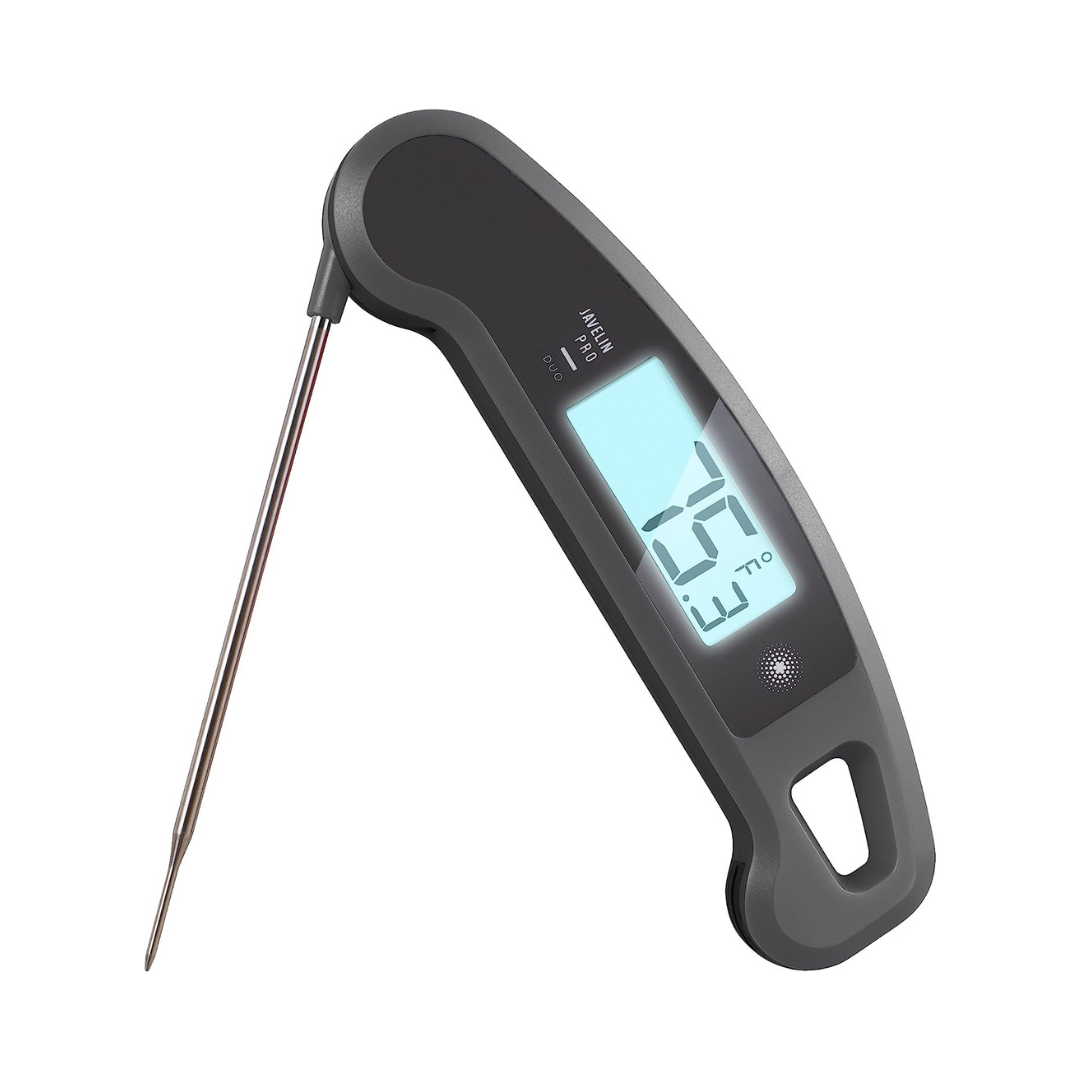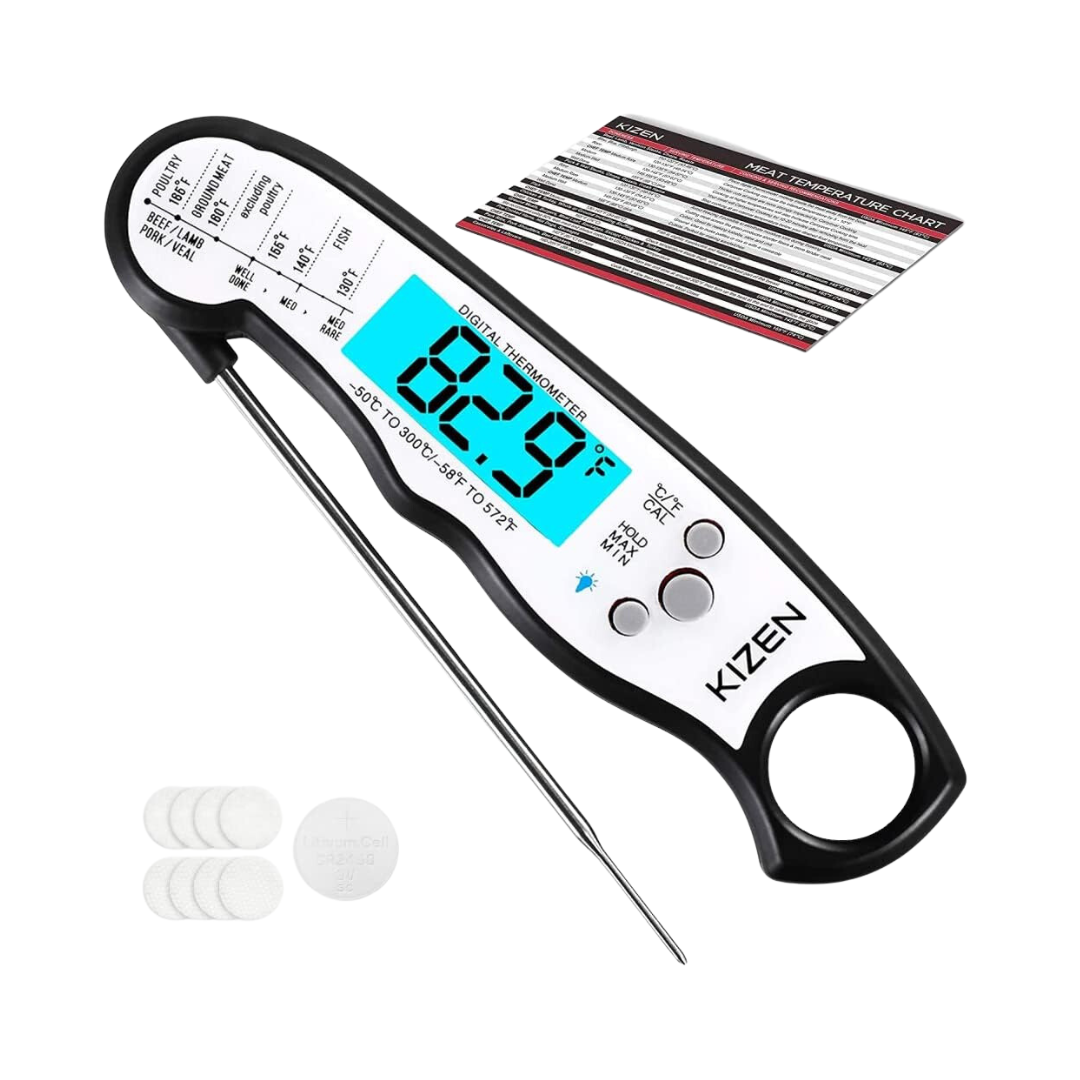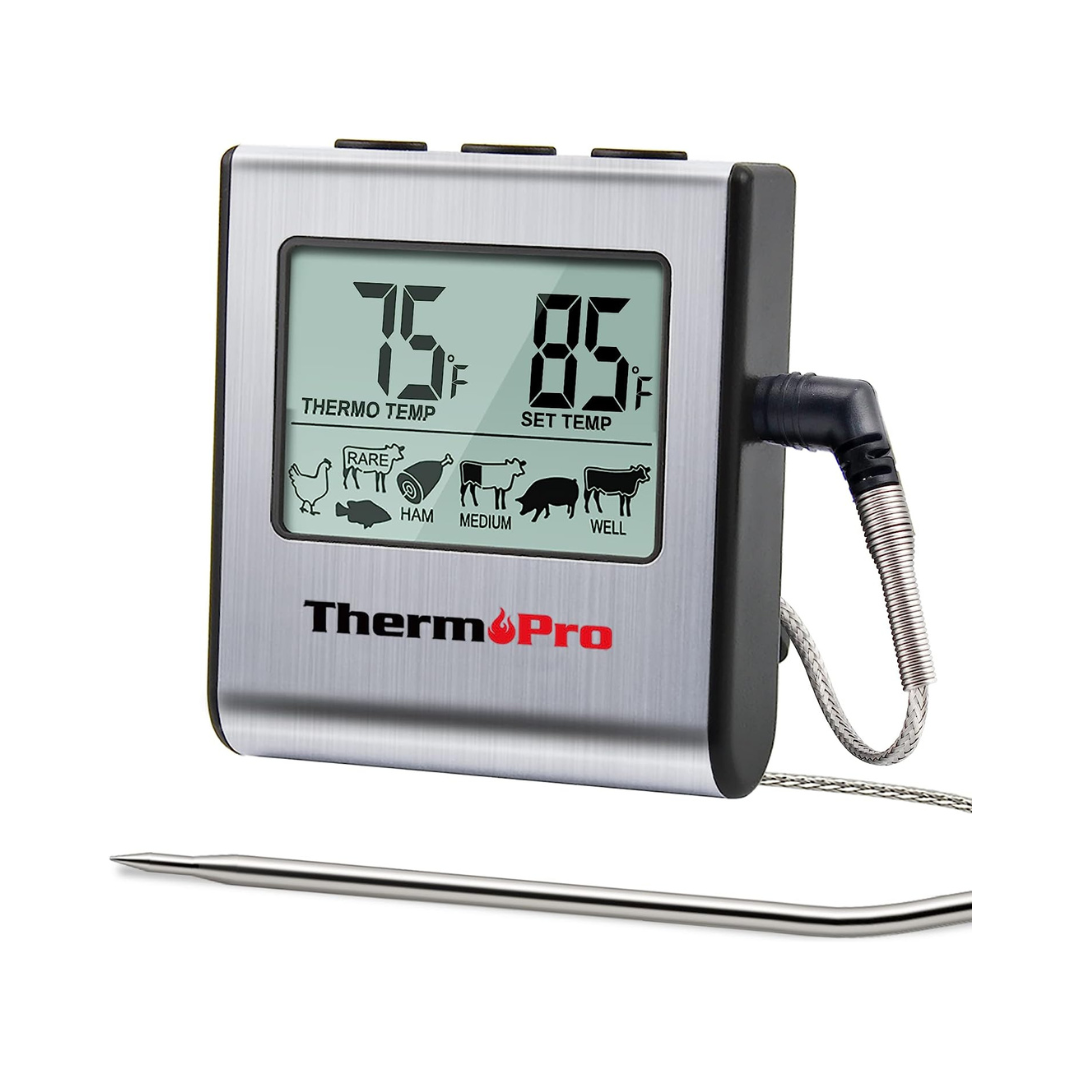We may be compensated if you purchase through links on our website. Our team is committed to delivering honest, objective, and independent reviews on home products and services.
A meat thermometer ensures that your meat is perfectly cooked to give you a flavorful and tender meal. While most meat thermometers today are digital instead of analog, you can still buy an instant-read device that tests the meat toward the end of the cooking process or a leave-in device that measures the temperature while it’s on the grill, in the smoker, or the oven.
Our team researched the best meat thermometers available today to help you decide which type will work best for your needs. Here are our top picks.
Top 4 Meat Thermometers
- Most Customizable: Lavatools Javelin PRO Duo
- Best Instructions: Kizen Instant-Read
- Best Leave-In Thermometer: ThermoPro TP-16
- Most Affordable: GDEALER DT11
Compare Top Meat Thermometers
| Product | Design | Read Time | Warranty |
|---|---|---|---|
| Lavatools Javelin PRO Duo Meat Thermometer | Instant-read | 1-3 seconds | 3 years |
| Kizen Instant-Read Meat Thermometer | Instant-read | 3 seconds or less | Lifetime |
| ThermoPro TP-16 Digital Cooking Thermometer | Leave-in | 0.5 seconds | Lifetime |
| GDEALER DT11 Meat Thermometer | Instant-read | 3-5 seconds | 1 year |
| Product | Design | Read Time | Warranty |
Most Customizable
Pros and Cons
✔ Displays temperature readings in one to three seconds
✔ The digital display features a read-out hold function, 360-degree viewing, and a splashproof construction
✔ Provides 4,000 hours of continuous use on a single battery
✘ Not ideal for budget-conscious shoppers
✘ Some customers cited issues with customer support
Key Features
- Instant-read design
- Read time of one to three seconds
- Bendable probe
- Three-year warranty
What Customers Are Saying
Customers cited its fast, accurate performance and easy-to-read display as the main reasons they enjoyed this product. Low-rated reviews mentioned that the thermometer stopped working at random; some were able to resolve this issue with customer support, while others weren’t.
Best Instructions
Pros and Cons
✔ Can withstand being dropped and washed with water
✔ Has a loop for hanging storage
✔ Can choose between Fahrenheit and Celcius readings
✘ Can’t be used with a deep fryer
✘ Has a longer temperature read time than other options, taking at least three seconds
Key Features
- Instant-read design
- Read time of as little as three seconds
- Bendable probe
- Lifetime warranty
What Customers Are Saying
Those who liked this product said it was easy to read and clean and gave quick and accurate temperature readings. Disappointed customers noted that the thermometer wasn’t waterproof like it was advertised, claiming that it stopped working after coming into contact with water.
Best Leave-In Thermometer
Pros and Cons
✔ Programmed with preset USDA-approved temperatures for different types of meat
✔ Allows you to set your temperature settings if you prefer
✔ Has a 40-inch stainless steel mesh cable that can withstand temperatures up to 716 degrees Fahrenheit
✘ The alarm that tells you when your food is cooked isn’t loud
✘ Requires frequent battery replacements
Key Features
- Leave-in design
- Programmable base station
- Lifetime warranty
What Customers Are Saying
Satisfied customers said the ThermoPro thermometer provided superior results at a price that can’t be beaten. Many were also thrilled with its easy-to-read display and durability. Unhappy customers said that the temperature readings were sometimes inaccurate.
Most Affordable
Pros and Cons
✔ Has a 4.5-inch probe, which is longer than other meat thermometers, for enhanced safety
✔ Includes a calibration function for ongoing accuracy
✔ Has a cap for the probe when it’s not in use
✘ The probe doesn’t fold down to save space when it’s not in use
✘ Only the tip is waterproof
Key Features
- Instant-read design
- Read time of three to five seconds
- Probe cap
- One-year warranty
What Customers Are Saying
Users noted how fast, accurate, and affordable this product was. However, a handful of dissatisfied customers mentioned that their thermometer stopped working after a short period.
Buying Guide to Meat Thermometers
The biggest factor to think about when choosing a meat thermometer is type. However, there are a few additional features that should also be considered.
Thermometer Type
While several types of tools can read the temperature of your meat, we stuck to leave-in or instant-read digital meat thermometers in this review because of how easy they are to use.
- Instant-read analog: Instant-read thermometers don’t remain in the meat the entire time you cook. Instead, you stick the probe into the thickest part of the meat to get an instant reading when you think the meat is close to being done.
- Leave-in analog: These thermometers also use an analog dial, except they stay in the meat while it’s cooking to give you a constant temperature reading.
- Instant-read digital: This type of meat thermometer is like an instant-read analog thermometer, except the reading is given to you in a digital format so that you don’t have to figure out the temperature yourself.
- Leave-in digital: Similar to a leave-in analog thermometer, this meat thermometer has a long cord that stays in the meat the entire time it’s cooking and connects to a base outside of the oven or grill.
- Leave-in wireless digital: These are similar to leave-in digital meat thermometers, except they transmit wirelessly to a base unit instead of being connected with a cord.
- Forks: These two-pronged devices are commonly used in grilling. They give an instant temperature reading.
- Disposable pop-ups: These are commonly used when cooking turkeys for holiday feasts. They pop up when the turkey has reached the recommended temperature of 165 degrees Fahrenheit.
Water Resistance
Your meat thermometer will be exposed to the moisture produced by the meat you’re cooking. This is especially true of instant-read models, as they have a shorter probe that comes into closer contact with the meat. Because of this, you’ll want a thermometer that’s either water-resistant or waterproof.
Temperature Range
The best meat thermometers have a large temperature range, allowing you to cook a variety of meats to their proper temperatures. Some thermometers even measure up to 600 degrees Fahrenheit.
Auto-Off Function
This feature is specific to digital thermometers because they use batteries to operate. If you forget to turn off your meat thermometer after using it, you’ll want to make sure that it doesn’t stay on until you pull it out next. An auto-off function will turn it off to prevent battery drainage.
Frequently Asked Questions About Meat Thermometers
Should you calibrate a meat thermometer?
Yes. Check your meat thermometer’s calibration at least once per year, when you first get it and whenever you drop it. You can do this by:
- Dipping it in ice water and seeing if it reads around 32 degrees Fahrenheit
- Dipping it in boiling water and seeing if it reads around 212 degrees Fahrenheit
If the readings aren’t correct, follow the recalibration instructions laid out in the owner’s manual. If the thermometer can’t be recalibrated, you may have to purchase a new one.
Where should I stick my meat thermometer?
This depends on the type of meat you’re cooking. Here is where to place the probe in a few common meats to get accurate readings:
- Ground meat, such as meatloaf: In the thickest area of the meat
- Roasts, steaks, and thick chops: In the center at the thickest part, away from bone, fat, and gristle
- Thin meat, such as hamburger patties: Sideways
- Whole poultry, such as turkey or chicken: In the inner thigh area near the breast but away from any bone
What happens if I don’t use a meat thermometer?
Without a meat thermometer, you won’t know if your meat is properly cooked. Undercooked meat can carry bacteria that could make you sick, and overcooked meat is tough and hard to chew.
How We Selected the Best Meat Thermometers
To provide our readers with the best recommendations possible, we rely on several key sources of information to help guide our selection process.
Initial Research: Our research process began by generating a list of thermometers with a significant number of verified buyer reviews and an average customer review rating of 4–5 stars. We looked at positive and negative reviews alike, focusing on information from both satisfied and critical buyers.
Expert Insights: Through our years of experience, we’ve learned that listening to what others have to say is key to building accurate, well-rounded articles. To complement our in-house expertise, our team looked at reviews and videos from trusted publications and independent testers, spoke with subject matter experts, and drew insights from reader contributions.
Final Product Selection: We then began fine-tuning our list by replacing older models with the latest versions and eliminating any discontinued models. From there, we pared the list down further by comparing each model’s feature set and selecting the best-in-class options for various buyers, budgets, and scenarios.
Why You Can Trust Us
This Old House has empowered homeowners and DIY-ers for more than four decades with top-notch home improvement advice in the form of television programs, print media, and digital content.
Our team focuses on creating in-depth product and service review content. To date, we’ve published over 1,600 reviews on products in the home space, from doorbell cameras and backyard fencing to pool vacuums and snow blowers.
Once we conclude our research, we craft a comprehensive, user-friendly article of recommended products and additional information to help our readers make the right purchase.
Questions or Comments?
To share feedback or ask a question about this article, send a note to our team at reviews@thisoldhousereviews.com.




